You are reading the older HTML site
Positive Feedback ISSUE 2
august/september 2002
"I Don’t Drive Stock!" Chapter 3: In Which Ye Olde
Editor Has His Caps Done
by David W. Robinson
(All photographs and digital image processing by David W. Robinson)
Background
It’s time for an update on modding my Sony SCD-1. Readers of Issue One (www.positive-feedback.com/Issue1/draudiocom.htm) will remember that I outlined the Audiocom modifications done by Richard Kern of Audiomod (www.audiomod.com), one of two fine audio modders/hot-rodders here in Portland (the other being the estimable Dan Wright of Modwright—www.modwright.com). The first chapter was the installation of the Audiocom Superclock, a $360 upgrade as performed by Kern. After listening to that through a break-in of more than 400 hours, I returned for the Audiocom Superclock Power Supply upgrade, and spent a couple of hundred hours breaking that in and gathering impressions. The results, in a nutshell, were spectacular—the Superclock added articulation and detail, while the Superclock Power Supply seemed to make the "black" blacker, creating a sense of deeper silence from which the articulation of the Superclock was even more evident. Great stuff! Details are in the article hyperlinked above.
But there’s more, of course. Richard encouraged me to try the next step in mod-dom—installing Black Gate capacitors in place of Sony’s Elnas on the analog/digital power supply board of the SCD-1. I had long since decided to take this step, but allowed each phase of the upgrading to happen in turn, with time to break in and evaluate the changes that each modification brings. Soooo… after several hundreds of hours, it was time to take the next step. Bring on the Black Gates.
Off to the Hot Mod Races!
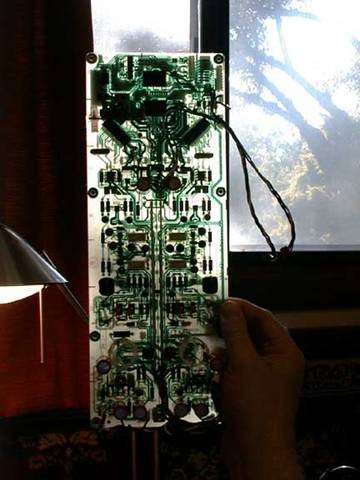
The analog/digital power supply board of the Sony SCD-1 SACD
player, in all its backlit glory...
Once again, I found myself at Audiomod, watching Richard heating up his trusty soldering and de-soldering gear. While waiting, Richard shared his enthusiasm for this upgrade, saying that I would really appreciate the difference the Black Gate capacitors made to the sound of the SCD-1. He isn’t alone in his appreciation for the Black Gates—my good friend Jennifer Crock of JENA Labs shares Richard’s appreciation for them. "Good stuff," sez Jen, and that’s the equivalent of a rousing Hallelujah Chorus for those of you who don’t know Jennifer! This made me all the more eager to hear what a cap upgrade could do for the SCD-1, already a fine piece of equipment.

Richard Kern's de-soldering station ready to go
I had heard of the Black Gates, but had never seen one. Richard was kind enough to share his trove with me before the installation, so that I could look them over and photograph them for you. There are such things as good-looking electronic components—strange as it sounds to the non-electrophile—and the Black Gates definitely had the look and feel of superior componentry. Of course, you can’t really be sure about the sound until you have a chance to hear them.
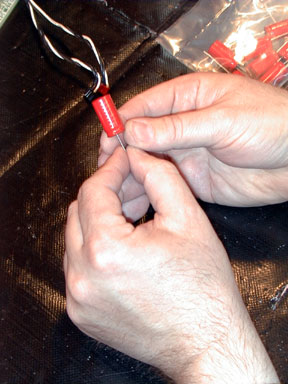
Richard Kern modeling one of the Black Gates—good show,
Richard!
Opening the Sony SCD-1 is always a bit of a remarkable event. It’s an exceptional and beautiful piece of audio design work—kudos to Sony!—and generally creates appreciation wherever it goes. Very few get to see the complex inside of the machine, though, which is why you should check immediately below.
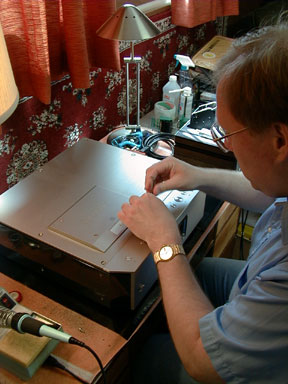
First, Kern carefully removes the SCD-1 lid…

…then, once the lid is off, you can see the gizzards of
an SCD-1;
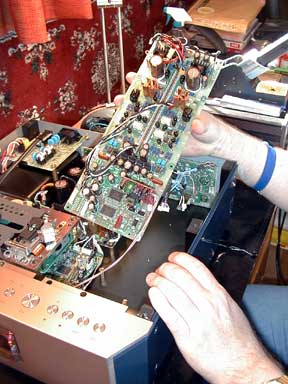
Kern removes the SCD-1 analog/digital power supply board
Taking the power supply board out only takes a few minutes. Richard has clearly done a number of these modifications. The equipment is well made, but you don’t want to make any mistakes—there’s no warranty "safety net!" Richard then patiently went about the process of desoldering the Elna caps from the SCD-1 power supply board. There are a lot of them, so the process took several hours. As always, I am impressed whenever I get to see a true fine audio artisan at work, and Richard is certainly one of that small group. His twenty-five years of experience with audio equipment showed once again, as he meticulously removed the old capacitors, and cleaned the board to receive the Black Gates.
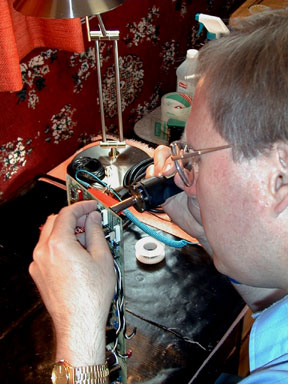
Kern carefully desolders yet another Elna cap…
Once the SCD-1 power supply board was ready to go, Richard began the insertion of the new capacitors. Working with real care, each capacitor was soldered in place and trimmed, all neatly done. Those of you who are concerned about risking your warranty for such modification work need not be. Richard’s workmanship is clearly first-rate, and his experienced attention to detail was faultless. At no point did I worry about the upgrade process, and neither should you.
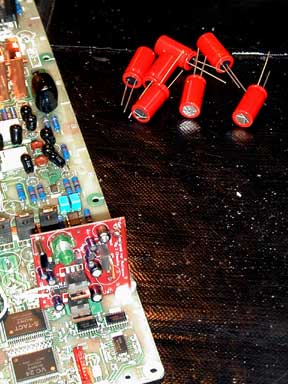
Some of the new Black Gate capacitors, sitting
Once the upgrade was done, I took the SCD-1 home for (yet another!) break-in session. I was eager to hear what the newly-modified component would sound like.
The Sound
While I confess to cheating, and listening to the SCD-1 up front, I knew that the capacitors would take time to hit their stride. For what it’s worth (fair warning), the brand-new sound of the Black Gates was a bit recessed and congested. The clarity of the Superclock/Superclock Power Supply was somewhat veiled by the new caps. Over the next several days, the congestion eased. By the time a week had gone by, the detail and clarity of the Superclock tandem was back, but there was an important new element. It took me a while to qualify what I was experiencing, but as the new mod passed 200 hours, I felt that I had a handle on it.
Most interesting! What I was hearing was all the articulation that the Superclock had brought, plus all the crystalline silence that the Superclock Power Supply rendered, but with an additional dimension. What had previously been detailed now had a certain silkiness, a richness that was extremely appealing. All this was done without compromising the gains that had been made by the Superclock upgrades! I would therefore say that the Black Gates are working mainly on the timbre of the recordings played through them. Soundstaging and imaging do not appear to be affected by the Black Gates—a good thing! I hasten to add that I would not characterize the timbral improvement wrought by the Superclock mods as euphonic. There is no sense of musical detail being burnished; instead, the detail is rendered with a refined silkiness that makes debates of "accuracy vs. musicality" academic. I believe that great recordings need to be delivered in all their glory, and with all their warts. This Black Gate capacitor upgrade is an important step along the way to delivering just that in the world of DSD and SACD. I certainly would not want my SCD-1 to be without it.
I must therefore quietly rave, my friends, about the Black Gate upgrade to the Sony SCD-1. It isn’t as startling or quite as obvious as the Superclock/Superclock Power Supply upgrades, which I consider to be sine qua non for SACD players that can be so modified, but its subtlety is nonetheless requisite for being less apparent at first glance. It’s that second glance that seduces you! If you can afford it after committing to the Superclock mods (which I consider to be essential first steps), then by all means do the Black Gate capacitor modifications as well. You won’t regret it. Do remember that you’ll need to let these caps break in for about 200 hours before they begin to come into their own. Until then, be patient!
Conclusion
There�s nothing else to say. This is a great mod! The Black Gate capacitor modification therefore rates a "Ye Olde Editor’s Highest Recommendation."
Next up: Chapter 4, in which Ye Olde Editor has his resistors upgraded! Stay tuned….
For more information, and current pricing:
Audiomod
www.audiomod.com
[email protected]
503-659-6599
